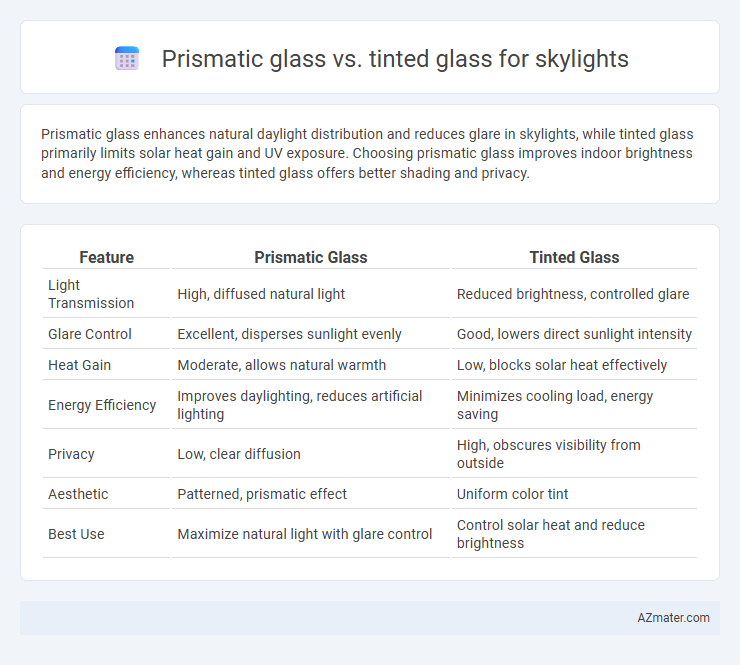Prismatic glass enhances natural daylight distribution and reduces glare in skylights, while tinted glass primarily limits solar heat gain and UV exposure. Choosing prismatic glass improves indoor brightness and energy efficiency, whereas tinted glass offers better shading and privacy.
Table of Comparison
| Feature | Prismatic Glass | Tinted Glass |
|---|---|---|
| Light Transmission | High, diffused natural light | Reduced brightness, controlled glare |
| Glare Control | Excellent, disperses sunlight evenly | Good, lowers direct sunlight intensity |
| Heat Gain | Moderate, allows natural warmth | Low, blocks solar heat effectively |
| Energy Efficiency | Improves daylighting, reduces artificial lighting | Minimizes cooling load, energy saving |
| Privacy | Low, clear diffusion | High, obscures visibility from outside |
| Aesthetic | Patterned, prismatic effect | Uniform color tint |
| Best Use | Maximize natural light with glare control | Control solar heat and reduce brightness |
Introduction to Skylight Glazing Options
Prismatic glass and tinted glass are popular skylight glazing options that enhance natural light control and energy efficiency in buildings. Prismatic glass diffuses sunlight to reduce glare and evenly distribute daylight, while tinted glass reduces solar heat gain and UV exposure by darkening the incoming light. Selecting the appropriate glazing depends on balancing light quality, heat control, and aesthetic preferences for the skylight installation.
What is Prismatic Glass?
Prismatic glass is specially designed with a textured surface to refract and diffuse natural sunlight, enhancing daylight distribution while reducing glare inside a space. Unlike tinted glass that simply darkens light and reduces heat gain, prismatic glass optimizes natural light penetration without significantly affecting visibility or color accuracy. This makes prismatic glass ideal for skylights where maximizing indirect daylight and minimizing harsh shadows are essential for comfort and energy efficiency.
What is Tinted Glass?
Tinted glass is a type of glass that has been treated with additives or dyes to reduce solar heat gain and glare by absorbing a portion of the sunlight. Commonly used in skylights, tinted glass enhances energy efficiency by minimizing ultraviolet (UV) radiation and visible light transmission. Its performance varies based on the tint color and density, making it a practical choice for controlling interior temperatures and improving occupant comfort.
Light Transmission and Diffusion
Prismatic glass for skylights enhances light diffusion by refracting sunlight, distributing illumination evenly to reduce glare and hotspots, while maintaining high light transmission rates typically between 70-85%. Tinted glass lowers light transmission by absorbing a portion of solar radiation, often transmitting 40-60% of visible light, which reduces glare and heat but provides less uniform light diffusion. Choosing prismatic glass optimizes daylight quality through balanced brightness and soft illumination, whereas tinted glass controls intensity at the expense of more directional, uneven light.
Heat Control and Energy Efficiency
Prismatic glass enhances heat control by diffusing sunlight evenly, reducing glare while minimizing solar heat gain, which improves overall energy efficiency in skylight installations. Tinted glass absorbs a significant portion of solar radiation, effectively lowering indoor temperatures but potentially decreasing natural light transmission. Choosing prismatic glass can lead to better daylight harvesting and consistent thermal regulation, whereas tinted glass offers stronger immediate heat reduction with less impact on energy savings from natural lighting.
Glare Reduction Capabilities
Prismatic glass offers superior glare reduction capabilities for skylights by diffusing incoming sunlight and distributing it evenly, reducing harsh shadows and bright spots. Tinted glass lowers glare by absorbing a portion of the light, but can darken interior spaces and reduce natural daylight levels. Selecting prismatic glass enhances visual comfort without significantly compromising natural illumination, making it ideal for glare-sensitive environments.
Aesthetic Appeal and Design Flexibility
Prismatic glass enhances skylight aesthetics by diffusing natural light evenly, creating a soft, visually appealing glow that minimizes glare and shadows, ideal for modern architectural designs focused on bright, harmonious interiors. Tinted glass offers superior design flexibility by providing a range of color options and varying levels of light filtration, allowing customization to match exterior facades and interior ambiance preferences while reducing solar heat gain. Both materials contribute uniquely to skylight design, with prismatic glass excelling in light quality and tint glass enhancing stylistic versatility and energy efficiency.
Privacy Considerations
Prismatic glass enhances privacy in skylights by diffusing natural light and obscuring visibility without compromising brightness. Tinted glass reduces glare and solar heat gain but may offer less privacy due to its transparency, especially in low-light conditions. Selecting prismatic glass is preferable for spaces requiring both daylight and higher privacy levels.
Cost Comparison: Prismatic vs. Tinted Glass
Prismatic glass for skylights typically commands a higher upfront cost due to its specialized light-diffusing properties that enhance natural illumination and reduce glare. Tinted glass, on the other hand, generally offers a more budget-friendly option by providing shading and UV protection while absorbing heat to improve energy efficiency. Long-term savings with prismatic glass may arise from reduced artificial lighting needs, whereas tinted glass helps lower cooling expenses but may require more frequent replacements due to fading or damage.
Choosing the Right Glass for Your Skylight
Prismatic glass enhances natural light diffusion while reducing glare, making it ideal for skylights in areas where balanced illumination is crucial. Tinted glass minimizes solar heat gain and UV radiation, providing energy efficiency and comfort in warmer climates. Selecting between prismatic and tinted glass depends on your priorities for light quality versus thermal control in your skylight installation.

Infographic: Prismatic glass vs Tinted glass for Skylight
 azmater.com
azmater.com